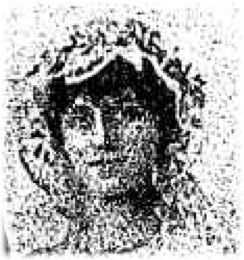Collingwood Notables Database
Charles Baker
1821-1897
Anglican layman, printer
Thomas Baker
1854-1928
Manufacturing chemist, inventor, photographer, philanthropist
Thomas Baker was a well-known Abbotsford identity for many years, living at Yarra Grange in Southampton Crescent and establishing the firm of Baker and Rouse which became the largest supplier of photographic material in Australia. He eventually became managing director of Kodak (Australasia) which continued to operate on the Yarra Grange site and surrounds until the 1950s.
Alice Baker, CBE
1855-1935
Philanthropist
Alice Baker’s name is immortalised in the Thomas Baker, Alice Baker, and Eleanor Shaw Medical Research Institute which was established at the Alfred Hospital in the 1920s, and continues its work as the Baker Heart and Diabetes Institute. An Abbotsford resident for almost 40 years, she was well-known for her philanthropic and social activities and her membership of many women’s groups. Towards the end of her life she was made a Commander of the Order of the British Empire.
William Barnard
c. 1828-1902
Baker, pastrycook, publican
Isaac Barnet
c.1825-1909
Pawnbroker, jeweller, councillor
Isaac Barnet was the first owner of Floraston, a notable house still standing in Victoria Parade and built for him in 1875. The house was designed by Terry and Oakden and built by local builders James Nation and Co. With its arched façade and ceramic tiled spandrels, it makes a significant contribution to the Victoria Parade streetscape.
Lisa Bellear
1961 - 2006
Indigenous artist, activist, academic, Collingwood Councillor
At the age of 27 Lisa Bellear become the City of Collingwood's first and only Aboriginal councillor. She went on to serve on the Victorian Stolen Generation Taskforce and Reconciliation Victoria. Not only a passionate advocate for Aboriginal rights, she was a broadcaster, photographer, dramatist and poet.
Mary Elsie Nathalie (Elsie) Berry
1882-1892
Elocutionist, elocution teacher
Elsie Berry, an elocutionist who grew up in Clifton Hill, represents a class of public performance which was very popular in the late nineteenth and early twentieth century but is rare nowadays. Elocution teachers proliferated partly through people’s desire to improve their everyday speech, but many were also popular performers. Concerts by elocutionists and their pupils were frequent, featuring character recitals, poetry, and humorous sketches, as well as songs and instrumental music. Elsie had a natural talent and even as a child showed an amazing gift of mimicry. After coming home from a concert she would throw the whole family into shrieks of laughter through her impersonations of one artist after the other.
Alfred Barrett Biggs
1825-1900
Teacher, inventor, astronomer
Alfred Biggs was appointed as the first head teacher at the United Methodist Free Church School in Hoddle Street Collingwood when it opened in 1858. He was assisted by his wife Harriet Biggs. The little school, funded under the auspices of the Denominational Board, consisted of a brick schoolroom measuring 38 feet by 24 feet, and a smaller timber building. It was on the southwest corner of Perry Street, and the young couple rented the conveniently nearby Clarendon Villa in Harmsworth Street. Their work would have been demanding. Most of the children would not have attended school prior to their arrival, and children of different ages would have contributed to the din in the small rooms. Moreover, Harriet, in charge of the Infants room, was also managing regular births and the sorrow of infant deaths; she had already had two children before starting at the school, the firstborn dying at the age of three months, and three more were born during her tenure, the last dying in April 1863. A month’s leave for childbirth was the norm, and Harriet’s health suffered.
Billibellary
c. 1799-1846
Aboriginal leader
Billibellary was an influential and important ngurungaeta, or spokesman, for the Wurundjeri–willum people at the time of the first European settlement of Melbourne. He was known as a chief of the Yarra tribe. His land was on the north side of the Yarra, including Yarra Bend Park and up the Merri Creek.
John Stirling Black
1832-1913
Chemist
Black took a position as assistant to the established chemist Carlington Marston in his Smith Street pharmacy and eventually took over the business. With two sons following him into pharmaceutical studies, the business continued into the 1930s as J.S. Black and Sons, and the 1867 building still exists.
Helen Bowie
1873-1959
Nurse, bacteriologist, amateur ethnographer, bird breeder, philanthropist, golfer
Helen Bowie, a resident of Queens Parade in Clifton Hill for over twenty years, was a nurse who studied bacteriology and worked in military hospitals in France in 1914-15. She assisted in organising and classifying the significant collection of stone implements and weapons amassed by her aunt’s husband, Dr George Horne. She was involved in a number of charitable concerns; she was also a keen golfer and became the first woman president of a golf club.
Henry Bradley
1831-1911
Tobacconist, fancy goods dealer, clay pipe manufacturer
Henry Bradley was the proud proprietor of a business in Smith Street Collingwood where he was a tobacconist and fancy goods dealer. According to Bradley’s biography in Victoria and its metropolis, his first shop was in the former residence of John Pascoe Fawkner, a founder of Melbourne, and a photo shows the name Fawkner House proudly emblazoned on the façade.
William Richard Butcher
1860-1933
Town clerk, tramways manager
W R Butcher held the position of Town Clerk of the City of Collingwood from 1907 until 1931, and was thus the longest-serving town clerk in the municipality until L. Dudley Cook (1962-1987). Prior to this appointment he was the manager of the Abbotsford tramway sheds which belonged to the Melbourne Tramway and Omnibus Company. He was an active member of St Philip’s Church.













